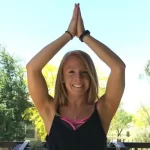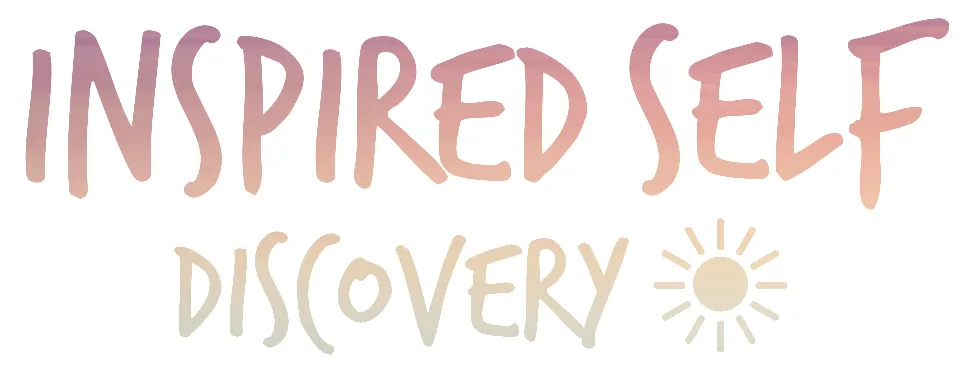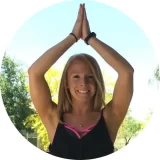An Energetic Heart Opening Yoga Sequence
Yoga poses that open our chest and heart space stretch us into backbends that can feel unnatural at
How to Move Into Chest Openers Correctly to Avoid Tightening
One of the reasons heart opening poses usually feel uncomfortable at first is that opening your rib cage doesn’t happen immediately. The rib cage can only open and expand by taking slow, calm breaths and patience.
The opposite is true of the breaths we take during a stress response. When we’re stressed our body attempts to protect our heart by either holding the breath or with short quick breaths. This can make for an uncomfortable yoga practice!
Move into chest openers slowly with deliberate breaths to avoid activating a stress response and actually causing a tightening of the chest. If you notice you have to hold your breath during a heart opening sequence to do a certain posture correctly, reset and try a more basic
Why Are Heart Opening Poses Good for Us?
Backbends allow us to counter-stretch the hunched-back posture that we tend to move into while sitting at a desk all day. I start feeling sore in my back and shoulders anytime I’ve been sitting at my desk for a long time without breaks and chest openers always help. For this reason alone, they’re awesome for helping us maintain good posture and decrease back and shoulder pain!
Heart opening poses also improve rib cage mobility, flush out toxins and stretch the thoracic soft tissues.
Lastly opening the chest symbolizes opening up your heart to the world and being open and confident. Research has proven that spending more time in “power poses” which are essentially body postures where your body is open and relaxed, reduces stress and increases confidence. You can read more about power poses in this Forbes article. Spending time in these poses subconsciously tells your body “You’ve got this!”
Heart Opening Yoga Sequence

1. Upward Dog
How to do upward facing dog :
Lay down on your stomach and put your hands flat on the ground next to the middle of your abdomen. Keeping the tops of your feet on the ground, lift your chest slightly. If you can without straining, straighten your arms and live your chest to the sky so that your back is arched, keeping your hands next to your sides and your gaze forward or upward.
P.S. for more details on this and a few other poses included in this blog post including health benefits of each pose and tips, check out my Yoga for Beginners blog post!

2. Bow Pose
How to do bow pose :
Lay face down on the floor and kick your feet up toward the ceiling, bending at the knees. Flex your feet and reach your arms backward to grab your ankles. Lift your chest up so that your back is arched, chest is lifted, and legs are being lifted to the ceiling.
Bonus tip: If you have trouble with this pose right off the bat, try doing a few shoulder stretches and then coming back to it!

3. Warrior One with Chest Opener Variation
How to do warrior one pose :
Standing up, step your feet wide apart turning your front foot to face forwards and your back foot to be in a 45-degree angle facing outwards. Lunge into your front leg and lift your arms up to the ceiling facing inwards towards your body. Lift your chest and your gaze and lean backward into an arch if you’re able to!

4. Camel Pose
How to do camel pose :
Get down on your knees with your shins on the ground, keeping your chest facing forwards and arms by your side. Rest your hands on the back of your pelvis with your hands on the top of your butt and fingers facing downwards. Start pressing your hips forwards and opening your chest, arching your back and gazing upwards. If you’re able to, reach your arms back towards your calves and grab them for support, arching your back and opening your chest.

5. Bridge or Wheel Pose
Bridge pose is a stepping stone to wheel pose. If you’ve already conquered bridge pose or are naturally flexible in your back, go for wheel pose! If you’re a beginner yogi start with bridge and build up to wheel.
How to do bridge pose :
Lay down on your back and lift your knees up while placing your feet flat on the floor. Place your arms down by your sides, pressing your hands and arms into the ground. Lift your hips up towards the sky, creating an arched back. Check out my Beginner Yoga blog post for more details on this pose!

How to do wheel pose :
Lay down with your back to the floor and your legs bent with feet flat on the ground. Reach your hands backward and place them on the ground next to your ears with your fingertips facing your feet. When you’re ready, press into your palms and your feet straightening your arms and lifting your hips off the ground and toward the ceiling. Keep your wrists facing your feet and work to get your legs as straight as possible.
For Advanced Yogis!
Once you’ve progressed through your yoga practice and have mastered the more basic chest openers, including how to move into them properly to avoid injury, learning more advanced backbends is the next step! For yogis that are advanced in their practice, what are your favorite backbends?!
Headstand + handstand with backbend variations

One of my new favorite backbends is the forearm wheel variation. This deep chest opener is a good one to strive toward because it gives you lots of leverage when working back flexibility, once you can do it safely.
Feel free to leave a comment and share any tips you have for chest openers / backbends. I’d love to hear from you!
If you liked this post, sign up for my newsletter below for resources to support your yoga practice and personal transformation, sent straight to your inbox!


Lauren Kessel is the author and owner of the Inspired Self Discovery blog. She is passionate about supporting personal growth and transformation in her life and others through yoga, mindfulness, spirituality and personal development. Lauren has been writing for over 15 years, practicing yoga for even longer, and has always had an interest in inner work.




No Comments